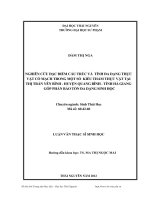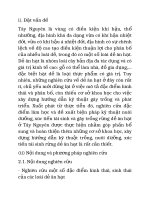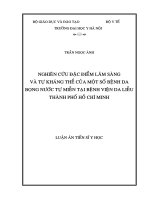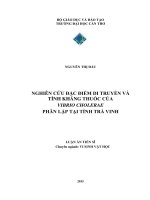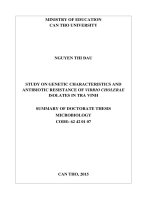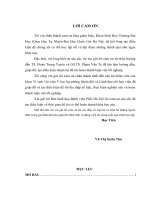Nghiên cứu đặc điểm sinh học và tính kháng kháng sinh của neisseria meningitidis tại các ổ dịch lưu hành trong quân đội
Bạn đang xem bản rút gọn của tài liệu. Xem và tải ngay bản đầy đủ của tài liệu tại đây (239.23 KB, 18 trang )
ĐẠI HỌC QUỐC GIA HÀ NỘI
TRƯỜNG ĐẠI HỌC KHOA HỌC TỰ NHIÊN
---------------------
VŨ THỊ XUÂN THU
NGHÊN CỨU ĐẶC ĐIỂM SINH HỌC VÀ TÍNH KHÁNG KHÁNG
SINH CỦA Neisseria meningitidis TẠI CÁC Ổ DỊCH
LƯU HÀNH TRONG QUÂN ĐỘI
LUẬN VĂN THẠC SĨ KHOA HỌC
Hà Nội - 2015
ĐẠI HỌC QUỐC GIA HÀ NỘI
TRƯỜNG ĐẠI HỌC KHOA HỌC TỰ NHIÊN
---------------------
VŨ THỊ XUÂN THU
NGHÊN CỨU ĐẶC ĐIỂM SINH HỌC VÀ TÍNH KHÁNG KHÁNG
SINH CỦA Neisseria meningitidis TẠI CÁC Ổ DỊCH
LƯU HÀNH TRONG QUÂN ĐỘI
Chuyên ngành: Vi sinh vật học
Mã số: 60420107
LUẬN VĂN THẠC SĨ KHOA HỌC
NGƯỜI HƯỚNG DẪN KHOA HỌC:
TS. ĐOÀN TRỌNG TUYÊN
GS. TS. PHẠM VĂN TY
Hà Nội – 2015
LỜI CẢM ƠN
Tôi xin chân thành cảm ơn Ban giám hiệu, Khoa Sinh Học-Trường Đại
Học Khoa Học Tự Nhiên-Đại Học Quốc Gia Hà Nội, đã hết lòng tạo điều
kiện để chúng tôi có thể học tập tốt và đạt được những thành quả như ngày
hôm nay.
Đặc biệt, với lòng biết ơn sâu sắc, tôi xin gửi lời cảm ơn tới thầy hướng
dẫn TS. Đoàn Trọng Tuyên và GS .TS. Phạm Văn Ty đã tâ ̣n tâm hướng dẫn ,
giúp đỡ, tạo điều kiện thuận lợi để tôi hoàn thành luận văn tốt nghiệp.
Tôi cũng xin gửi lời cảm ơn chân thành nhấ t đế n cán bô ̣ nhân viên của
khoa Vi sinh Vật viê ̣n Y họ c Dự phòng Quân đội và Lañ h đa ̣o chỉ huy viện đã
giúp đỡ và tạo điều kiện để tôi thu thập số liệu , thực hiện nghiên cứu và hoàn
thành luận văn tốt nghiệp.
Xin gửi tới Ban lãnh đạo Bệnh viện Phổi Hà Nội lời cảm ơn sâu sắc đã
tạo điều kiện về thời gian để tôi có thể hoàn thành khóa học này.
Một lần nữa, tôi xin gửi lời cảm ơn tới các thầy cô, bạn bè và toàn bộ
những người thân trong gia đình đã luôn giúp đỡ nhiệt tình và động viên tôi
trong suốt quá trình học tập.
Học Viên
Vũ Thị Xuân Thu
DANH MỤC CÁC TỪ VIẾT TẮT
NMC:
Não mô cầu
VMN:
Viêm màng não
PS:
Polysaccharide
LOS:
Lipo – oligosaccharide
LPS:
Lipopolysaccharide
OMP:
OuRer membrase protein
PCR:
Polymerase chain reaction
MIC
Minimum inhibition concentration
VSV:
Vi sinh vật
MỞ ĐẦU
Viêm màng não là một bệnh lý nhiễm trùng nghiêm trọng, tỷ lệ tử vong
cao nếu không được nghĩ đến, không chẩn đoán và điều trị kịp thời. Sự hiểu
biết về các tác nhân gây bệnh thường gặp, sẽ hỗ trợ cho công tác điều trị và
xây dựng các chương trình phòng chống bệnh tật tại từng Quốc gia. Hầu hết
những dữ liệu về dịch tễ của viêm màng não mủ ở người lớn đều xuất phát từ
những quốc gia đã phát triển, trong đó 4 tác nhân gây bệnh thường gặp nhất
là: Streptococcus pneumoniae (30%-60%), Neisseria meningitidis (13-37%),
Listeria monocytogenes và Haemophilus influenzae. Neisseria meningitidis,
Haemophilus influenzae type b (Hib) và Streptococcus pneumoniae là loại vi
khuẩn có vỏ (polysaccharide-encapsuleated) là nguyên nhân quan trọng gây
bệnh và tử vong trên thế giới [23] Hàng năm có từ 400.000 – 500.000 người
chết do viêm màng não (WHO, 2006).
Trong thời gian cuối thế kỷ 20 và đầu thế kỷ 21, đã có sự chuyển đổi
trong việc chẩn đoán các tác nhân sinh học, kết hợp kiểu hình và huyết thanh
học với việc xác định kiểu gene bằng các kỹ thuật sinh học phân tử [39].
Phân tích tính đa dạng về tổ hợp trình tự nhiều vùng gene (MLST) là tiêu
chuẩn vàng cho việc xác định các đặc điểm của vi khuẩn N. meningitidis phục
vụ công tác giám sát dịch tễ học. Sự phát triển của các kỹ thuật phân tử cho
phép phân tích vi khuẩn gây viêm màng não từ mẫu nuôi cấy phân lập và
không phân lập để chẩn đoán xác định được ca bệnh và nó trở thành công cụ
hữu ích cho nâng cao chất lượng giám sát, phát hiện và tiên lượng dịch, đây là
chiến lược phòng ngừa chính ở các nước Châu âu [7].
Nhằm nâng cao chất lược, hiệu quả của việc phát hiện tác nhân trên cơ
sở xác định đặc điểm về cả kiểu hình và kiểu gene của Neisseria meningitidis
là hết sức quan trọng giúp tiên lượng, dự báo dịch và đề xuất phác đồ dự
phòng, điều trị nhằm hạn chế được tỷ lệ nhiễm N. meningitidis, mắc bệnh
1
trong cộng đồng. Với đề tài nghiên cứu: “ Nghiên cứu đặc điểm sinh học và
tính kháng kháng sinh của Neisseria meningitidis tại các ổ dịch lưu hành
trong quân đội. Với mục tiêu:
1. Xác định đặc điểm sinh học và cơ cấu nhóm huyết thanh của
Neisseria meningitidis phân lập tại một số đơn vị tân binh trong quân đội.
2. Xác định tính nhạy cảm kháng sinh của các chủng Neisseria
meningitidis phân lập từ người mang mầm bệnh không triệu chứng
2
3
TÀI LIỆU THAM KHẢO
[1].Achtman M. (1995), "Epidemic spread and antigenic variability of Neisseria
meningitidis", Trends in Microbiology. 3 (5), pp. 186-192.
[2]. Bentley, S. D., G. S. Vernikos, L. A. Snyder, C. Churcher, C. Arrowsmith, T.
Chillingworth, A. Cronin, P. H. Davis, N. E. Holroyd, K. Jagels, M. Maddison, S.
Moule, E. Rabbinowitsch, S. Sharp, L. Unwin, S. Whitehead, M. A. Quail, M.
Achtman, B. Barrell, N. J. Saunders, and J. Parkhill (2007), “Meningococcal
genetic variation mechanisms viewed through comparative analysis of serogroup C
strain FAM18”, PLoS Genetics 3, pp. 23.
[3]. Boisier, P., P. Nicolas, S. Djibo, M. K. Taha, I. Jeanne, H. B. Mainassara, B.
Tenebray, K. K. Kairo, D. Giorgini, and S. Chanteau (2007), “Meningococcal
meningitis: unprecedented incidence of serogroup X-related cases in 2006 in
Niger”, Clinical Infectious Diseases 44, pp. 657-663.
[4]. Borel, T., A. M. Rose, M. Guillerm, F. Sidikou, S. Gerstl, A. Djibo, N. Nathan,
S. Chanteau, and P. J. Guerin (2006), “High sensitivity and specificity of the
Pastorex latex agglutination test for Neisseria meningitidis serogroup A during a
clinical trial in Niger”, Transactions of the Royal Society of Tropical Medicine and
Hygiene 100, pp. 964-969.
[5]. Borrow, R., H. Claus, U. Chaudhry, M. Guiver, E. B. Kaczmarski, M. Frosch,
and A. J. Fox (1998), “siaD PCR ELISA for confirmation and identification of
serogroup Y and W135 meningococcal infections”, FEMS Microbiology Letters
159, pp. 209-214.
[6]. Borrow, R., H. Claus, M. Guiver, L. Smart, D. M. Jones, E. B. Kaczmarski, M.
Frosch, and A. J. Fox (1997), “Non-culture diagnosis and serogroup determination
of meningococcal B and C infection by a sialyltransferase (siaD) PCR ELISA”,
Epidemiology and Infection 118, pp.111-117.
[7]. Broome CV (1986),“The carrier state: Neisseria meningitidis” , J Antimicrob
Chemother 18 (Suppl. A), pp. 25–34.
4
[8]. Bundle, D. R., H. J. Jennings, and C. P. Kenney (1974), “Studies on the groupspecific polysaccharide of Neisseria meningitidis serogroup X and an improved
procedure for its isolation”, Journal of Biological Chemistry 249, pp. 4797-4801.
[9]. Bustin, S. A (2004), “The PCR Revolution. Basic technologies and
Applications”, Cambridge University Press.
[10]. Caugant DA, Høiby EA, Magnus P, Scheel O, Hoel T, Bjune G, Wedege E,
Eng J & Frøholm LO (1994), “Asymptomatic carriage of Neisseria meningitidis in a
randomly sampled population”. J Clin Microbiol 32, pp. 323–330.
[11]. Cartwright K (1995), “Meningococcal carriage and disease. Meningococcal
Disease” (CartwrightK, ed), pp. 115–146.
[12]. Carvalho, M. G., M. L. Tondella, K. McCaustland, L. Weidlich, L. McGee, L.
W. Mayer, A. Steigerwalt, M. Whaley, R. R. Facklam, B. Fields, G. Carlone, E. W.
Ades, R. Dagan, and J. S. Sampson (2007), “Evaluation and improvement of realtime PCR assays targeting lytA, ply, and psaA genes for detection of pneumococcal
DNA”. Journal of Clinical Microbiology 45, pp. 2460-2466.
[13]. Cedric Mims (1996), “The Pathogenesis of the Acute Exanthemst”. Review
in Medical Virology. Vol 6, pp. 1-8.
[14]. Clare L. Bennett, Erwin van Rijn, Steffen Jung, Kayo Inaba, Ralph M.
Steinman, Martien L. Kapsenberg, and Björn E. Clausen (2005), “Inducible ablation
of mouse langerhans cells diminishes but fails to abrogate contact hypersensitivity”,
The Journal of Cell Biology, Vol 169, No 4,pp. 569-576.
[15]. Claus, H., R. Borrow, M. Achtman, G. Morelli, C. Kantelberg, E. Longworth,
M. Frosch, and U. Vogel (2004), “Genetics of capsule O-acetylation in serogroup
C, W-135, and Y meningococci”, Molecular Microbiology 51, pp. 227-239.
[16]. Claus, H., M. C. Maiden, R. Maag, M. Frosch, and U. Vogel (2002), “Many
carried meningococci lack the genes required for capsule synthesis and transport”,
Microbiology 148, pp. 1813-1819.
5
[17]. Claus, H., U. Vogel, M. Muhlenhoff, R. Gerardy-Schahn, and M. Frosch (1997),
“Molecular divergence of the sia locus in different serogroups of Neisseria
meningitidisexpressing polysialic acid capsules”, Molecular and General Genetics 257,
pp. 28-34.
[18]. Corless, C. E., M. Guiver, R. Borrow, V. Edwards-Jones, A. J. Fox, and E. B.
Kaczmarski
(2001),
“Simultaneous
detection
of
Neisseria
meningitidis,
Haemophilus influenzae, and Streptococcus pneumoniae in suspected cases of
meningitis and septicemia using real-time PCR”, Journal of Clinical Microbiology
39, pp. 1553-1558.
[19]. Csako, G. (2006) “Present and future of rapid and/or high-throughput methods
for nucleic acid testing”, Clinica Chimica Acta 363, pp. 6-31.
[20]. Dolan-Livengood, J. M., Y. K. Miller, L. E. Martin, R. Urwin, and D. S.
Stephens (2003), “Genetic basis for nongroupable Neisseria meningitidis”. Journal
of Infectious Diseases 187, pp. 1616-1628.
[21]. Dolan Thomas, J., C.P. Hatcher, D.A. Satterfield, M.J. Theodore, M.C. Bach,
K.B. Linscott, X. Zhao, X. Wang, R. Mair, S. Schmink, K.E. Arnold, D.S. Stephens,
L.H. Harrison, R.A. Hollick, A.L. Andrade, J. Lamaro-Cardoso, A.P.S. de Lemos, J.
Gritzfeld, S. Gordon, A. Soysal, M. Bakir, D. Sharma, S. Jain, S.W. Satola, N.E.
Messonnier, and L.W. Mayer (2011), “sodC-Based Real-Time PCR for Detection of
Neisseria meningitidis”, PLoS One 6, e19361.
[22]. Edwards, U., A. Muller, S. Hammerschmidt, R. Gerardy-Schahn, and M.
Frosch (1994), “Molecular analysis of the biosynthesis pathway of the alpha-2,8
polysialic acid capsule by Neisseria meningitidis serogroup B”, Molecular
Microbiology 14, pp.141-149.
[23]. Falla, T. J., D. W. Crook, L. N. Brophy, D. Maskell, J. S. Kroll, and E. R.
Moxon (1994), “PCR for capsular typing of Haemophilus influenzae”. Journal of
Clinical Microbiology 32, pp. 2382-2386.
6
[24]. Frosch, M., U. Edwards, K. Bousset, B. Krausse, and C. Weisgerber (1991),
“Evidence for a common molecular origin of the capsule gene loci in gram-negative
bacteria expressing group II capsular polysaccharides”, Molecular Microbiology 5,
pp. 1251-1263.
[25]. Frosch, M., and A. Muller (1993), “Phospholipid substitution of capsular
polysaccharides and mechanisms of capsule formation in Neisseria meningitidis”.
Molecular Microbiology 8, pp. 483-493.
[26]. Gagneux, S. P., A. Hodgson, T. A. Smith, T. Wirth, I. Ehrhard, G. Morelli, B.
Genton, F. N. Binka, M. Achtman, and G. Pluschke (2002), “Prospective study of a
serogroup X Neisseria meningitidis outbreak in northern Ghana”, Journal of
Infectious Diseases 185, pp. 618-626.
[27]. Ganguli, S., G. Zapata, T. Wallis, C. Reid, G. Boulnois, W. F. Vann, and I. S.
Roberts (1994), “Molecular cloning and analysis of genes for sialic acid synthesis in
Neisseria meningitidis group B and purification of the meningococcal CMPNeuNAc synthetase enzyme”, Journal of Bacteriology 176, pp. 4583-4589.
[28]. Goldacre M J, Trevor Lambert, Julie Evans, Gill Turner. “Preregistrantion
house officers’ views on whether their experience at medical school prepared them
well for their jobs: national questionnaise survey”. BMJ Volume 326, pp. 10111012.
[29]. Hammerschmidt, S., C. Birkholz, U. Zahringer, B. D. Robertson, J. van
Putten, O. Ebeling, and M. Frosch (1994), “Contribution of genes from the capsule
gene complex 53(cps) to lipooligosaccharide biosynthesis and serum resistance in
Neisseria meningitidis”. Molecular Microbiology 11, pp. 885-896.
[30]. Hammerschmidt, S., A. Muller, H. Sillmann, M. Muhlenhoff, R. Borrow, A. Fox,
J. van Putten, W. D. Zollinger, R. Gerardy-Schahn, and M. Frosch ( 1996), “Capsule
phase variation in Neisseria meningitidis serogroup B by slipped-strand mispairing
in the polysialyltransferase gene (siaD): correlation with bacterial invasion and the
outbreak of meningococcal disease”, Molecular Microbiology 20, pp. 1211-1220.
7
[31]. Hongfei Zhu, Quan Wang, Liuqing Wen ,Jianguo Xu,Zhujun Shao, Min Chen,
Mingliang Chen, Peter R. Reeves ,Boyang Cao,và Lei Wang “Development of a
Multiplex PCR Assay for Detection and Genogrouping of Neisseria meningitidis” J Clin
Microbiol.
2012
January;
50(1):
46–51.:
10.1128/JCM.00918-11PMCID:
PMC3256684”.
[31]. Janson, H., M. Ruan, and A. Forsgren (1993), “Limited diversity of the protein
D gene (hpd) among encapsulated and nonencapsulated Haemophilus influenzae
strains”, Infection and Immunity 61, pp. 4546-4552.
[32]. Kroll, J. S. (1992), “The genetics of encapsulation in Haemophilus
influenzae”. Journal of Infectious Diseases 165 Suppl 1, pp. 93-96.
[33]. Kroll, J. S., B. M. Loynds, and E. R. Moxon (1991), “The Haemophilus
influenzae capsulation gene cluster: a compound transposon”, Molecular
Microbiology 5, pp. 1549-1560.
[34]. Kroll, J. S., and E. R. Moxon (1988), “Capsulation and gene copy number at the
cap locus of Haemophilus influenzae type b”, Journal of Bacteriology 170, pp. 859-864.
[35]. Kroll, J. S., S. Zamze, B. Loynds, and E. R. Moxon (1989), “Common
organization of chromosomal loci for production of different capsular polysaccharides
in Haemophilus influenzae”, Journal of Bacteriology 171, pp. 3343-3347.
[36]. LaClaire, L. L., M. L. Tondella, D. S. Beall, C. A. Noble, P. L. Raghunathan,
N. E. Rosenstein, and T. Popovic (2003), “Identification of Haemophilus influenzae
serotypesby standard slide agglutination serotyping and PCR-based capsule typing”,
Journal of Clinical Microbiology 41, pp.393-396.
[37]. Lee, L. G., C. R. Connell, and W. Bloch (1993), “Allelic discrimination by
nicktranslation PCR with fluorogenic probes”, Nucleic Acids Research 21, pp.
3761-3766.
[38]. Liu, T. Y., E. C. Gotschlich, E. K. Jonssen, and J. R. Wysocki (1971),
“Studies on the meningococcal polysaccharides. I. Composition and chemical
properties of the group A polysaccharide”, Journal of Biological Chemistry 246, pp.
2849-2858.
8
[39]. Martin C.J. Maiden and Mathias Frosch (2001), “Molecular Techniques for
the
Investigation
of
Meningococcal
Disease
Epidemiology”,
Molecular
Biotechnology, Volume 18, pp. 119-134.
[40]. Masson, L., and B. E. Holbein (1983), “Physiology of sialic acid capsular
polysaccharide synthesis in serogroup B Neisseria meningitidis”, Journal of
Bacteriology 154, pp. 728-736.
[41N]. Marcelo Reyes, Juan Pablo Torres, Valeria Prado, Roberto Vidal. “Multiplex
PCR assay in spinal fluid to identify simultaneously bacterial pathogens associated to
acute bacterial meningitis in Chilean children”, Rev Méd Chile 2008; 136, pp. 338346.
[41]. Messmer, T. O., J. S. Sampson, A. Stinson, B. Wong, G. M. Carlone, and R.
R. Facklam (2004), “Comparison of four polymerase chain reaction assays for
specificity in the identification of Streptococcus pneumoniae”, Diagnostic
Microbiology and Infectious Disease 49, pp. 249-254.
[42]. Moore, C. E., A. Sengduangphachanh, T. Thaojaikong, J. Sirisouk, D. Foster,
R. Phetsouvanh, L. McGee, D. W. Crook, P. N. Newton, and S. J. Peacock (2010),
“Enhanced determination of Streptococcus pneumoniae serotypes associated with
invasive disease in Laos by using a real-time polymerase chain reaction serotyping
assay with cerebrospinal fluid”, American Journal of Tropical Medicine and
Hygiene 83, pp. 451-457.
[43]. Mothershed, E. A., C. T. Sacchi, A. M. Whitney, G. A. Barnett, G. W. Ajello,
S. Schmink, L. W. Mayer, M. Phelan, T. H. Taylor, Jr., S. A. Bernhardt, N. E.
Rosenstein, and T. Popovic (2004),
“Use of real-time PCR to resolve slide
agglutination discrepancies in serogroup identification of Neisseria meningitidis”.
Journal of Clinical Microbiology 42, pp. 320-328.
[43] Muhamed-kheir TaHa “Simultaneous approach for nonculture PCR base
indentification and serogroup prediction of N”. meningitidis journal of clinical
microbiology.Feb, 2000, pp. 855-857 .
9
[44]. Mullis, K. B., and F. A. Faloona (1987), “Specific synthesis of DNA in vitro via a
polymerase-catalyzed chain reaction”, Methods In Enzymology 155, pp. 335-350
[45]. Murdoch, D. R., T. P. Anderson, K. A. Beynon, A. Chua, A. M. Fleming, R.
T. Laing, G. I. Town, G. D. Mills, S. T. Chambers, and L. C. Jennings (2003),
“Evaluation of a PCR assay for detection of Streptococcus pneumoniae in
respiratory and nonrespiratory samples from adults with community-acquired
pneumonia”. Journal of Clinical Microbiology 41, pp. 63-66.
[46]. Pai, R., R. E. Gertz, and B. Beall (2006), “Sequential multiplex PCR approach
for determining capsular serotypes of Streptococcus pneumoniae isolates”, Journal
of Clinical Microbiology 44, pp. 124-131.
[47]. Parkhill, J., M. Achtman, K. D. James, S. D. Bentley, C. Churcher, S. R. Klee,
G. Morelli, D. Basham, D. Brown, T. Chillingworth, R. M. Davies, P. Davis, K.
Devlin, T. Feltwell, N. Hamlin, S. Holroyd, K. Jagels, S. Leather, S. Moule, K.
Mungall, M. A. Quail, M. A. Rajandream, K. M. Rutherford, M. Simmonds, J.
Skelton, S.
Whitehead, B. G. Spratt, and B. G. Barrell (2000), “Complete DNA sequence of a
serogroup A strain of Neisseria meningitidis Z2491”, Nature 404, pp. 502-506.
[48]. Robert K. Selander, Dominique A. Caugant, Howard Ochaman, James M.
Musser, Marion N. Gilmour, and Thomas Whittam (1986), “Methods of Multilocus
Enzyme Electrophoresis for Bacterial Population Genetics and Systematics”,
Applied and Enviromental Microbiology, pp. 873-884.
[49]. Resti, M., M. Moriondo, M. Cortimiglia, G. Indolfi, C. Canessa, L. Becciolini,
E. Bartolini, F. M. de Benedictis, M. de Martino, and C. Azzari (2010),
“Communityacquired bacteremic pneumococcal pneumonia in children: diagnosis
and serotyping by real-time polymerase chain reaction using blood samples”,
Clinical Infectious Diseases 51, pp. 1042-1049.
[50]. Sadler, F., A. Fox, K. Neal, M. Dawson, K. Cartwright, and R. Borrow (
2003), “Genetic analysis of capsular status of meningococcal carrier isolates”,
Epidemiology and Infection 130, pp. 59-70.
10
[51]. Saiki, R. K., S. Scharf, F. Faloona, K. B. Mullis, G. T. Horn, H. A. Erlich, and
N. Arnheim (1985), “Enzymatic amplification of beta-globin genomic sequences
and restriction site analysis for diagnosis of sickle cell anemia”, Science 230, pp.
1350-1354.
[52]. Satola, S. W., P. L. Schirmer, and M. M. Farley (2003), “Complete sequence of
the cap locus of Haemophilus influenzae serotype b and nonencapsulated b capsulenegative variants”, Infection and Immunity 71, pp. 3639-3644.
[53]. Satola, S. W., P. L. Schirmer, and M. M. Farley (2003), “Genetic analysis of
the capsule locus of Haemophilus influenzae serotype f”, Infection and Immunity
71, pp. 7202-7207.
[54]. Song, X. M., A. Forsgren, and H. Janson (1995), “The gene encoding protein
D (hpd) is highly conserved among Haemophilus influenzae type b and nontypeable
strains”. 63, pp. 696-699.
[55]. Steven M. Pollard, Koichi Yoshikawa, Ian D. Clarke, Davide Danovi, Stefan
Strieker, Roslin Russell, Jane Bayani, Renee Head, Marco Lee, Mark Bernstein,
Jeremy A. Squire, Austin Smith, and Peter Dirks (2009), “Glioma Stem Cell Lines
Expanded in Adherent Culture Have Tumor- Specific Phenotypes and Are Suiable
for Chemical and Genetic Screens”, Cell stem cell 4, pp. 568-580.
[56]. Stratagene (2006), “Introduction to Quantitative PCR: Methods and
Application Guide”.
[57]. Suzuki, N., M. Yuyama, S. Maeda, H. Ogawa, K. Mashiko, and Y. Kiyoura
(2006), “Genotypic identification of presumptive Streptococcus pneumoniae by
PCR using four genes highly specific for S. Pneumoniae”, Journal of Medical
Microbiology 55, pp. 709-714.
[58]. Swartley, J. S., J. H. Ahn, L. J. Liu, C. M. Kahler, and D. S. Stephens (1996),
“Expression of sialic acid and polysialic acid in serogroup B Neisseria meningitidis:
divergent transcription of biosynthesis and transport operons through a common
promoter region”, Journal of Bacteriology 178, pp. 4052-4059.
11
[59]. Swartley, J. S., L. J. Liu, Y. K. Miller, L. E. Martin, S. Edupuganti, and D. S.
Stephens (1998), “Characterization of the gene cassette required for biosynthesis of
the
(alpha1-->6)-linked
N-acetyl-D-mannosamine-1-phosphate
capsule
of
serogroup A Neisseria meningitidis”, Journal of Bacteriology 180, pp. 1533-1539.
55
[60]. Swartley, J. S., A. A. Marfin, S. Edupuganti, L. J. Liu, P. Cieslak, B. A.
Perkins, J. D. Wenger, and D. S. Stephens (1997), “Capsule switching of Neisseria
meningitidis”, Proceedings of the National Academy of Sciences of the United
States of America 94, pp. 271-276.
[61]. Swartley, J. S., and D. S. Stephens (1994), “Identification of a genetic locus
involved in the biosynthesis of N-acetyl-D-mannosamine, a precursor of the (alpha
2-->8)-linked polysialic acid capsule of serogroup B Neisseria meningitidis”,
Journal of Bacteriology 176, pp. 1530-1534.
[62].Taha, M.-K (2000), “Simultaneous approach for nonculture PCR-based
identification and serogroup prediction of Neisseria meningitidis”, Journal of
Clinical Microbiology 38, pp. 855-857.
[63]. Taha, M. K., J. M. Alonso, M. Cafferkey, D. A. Caugant, S. C. Clarke, M. A.
Diggle, A. Fox, M. Frosch, S. J. Gray, M. Guiver, S. Heuberger, J. Kalmusova, K.
Kesanopoulos, A. M. Klem, P. Kriz, J. Marsh, P. Mölling, K. Murphy, P. Olcén, O.
Sanou, G. Tzanakaki, and U. Vogel (2005), “Interlaboratory comparison of PCRbased identification and genogrouping of Neisseria meningitidis”, Journal of
Clinical Microbiology 43, pp. 144-149.
[64]. Tarrago, D., A. Fenoll, D. Sanchez-Tatay, L. A. Arroyo, C. Munoz-Almagro,
C. Esteva, W. P. Hausdorff, J. Casal, and I. Obando (2008), “Identification of
pneumococcal serotypes from culture-negative clinical specimens by novel realtime PCR”, Clinical Microbiology and Infection 14, pp. 828-834.
[65]. Tettelin, H., N. J. Saunders, J. Heidelberg, A. C. Jeffries, K. E. Nelson, J. A.
Eisen, K. A. Ketchum, D. W. Hood, J. F. Peden, R. J. Dodson, W. C. Nelson, M. L.
Gwinn, R. DeBoy, J. D. Peterson, E. K. Hickey, D. H. Haft, S. L. Salzberg, O.
12
White, R. D. Fleischmann, B. A. Dougherty, T. Mason, A. Ciecko, D. S. Parksey,
E. Blair, H. Cittone, E. B. Clark, M. D. Cotton, T. R. Utterback, H. Khouri, H. Qin,
J. Vamathevan, J. Gill, V. Scarlato, V. Masignani, M. Pizza, G. Grandi, L. Sun, H.
O. Smith, C. M. Fraser, E. R. Moxon, R. Rappuoli, and J. C. Venter (2000),
“Complete genome sequence of Neisseria meningitidis serogroup B strain MC58”,
Science 287, pp. 1809-1815.
[66]. Tzeng, Y.-L., C. Noble, and D. S. Stephens (2003), “Genetic basis for
biosynthesis of the (alpha 1-->4)-linked N-acetyl-D-glucosamine 1-phosphate capsule
of Neisseria meningitidis serogroup X”, Infection and Immunity 71, pp. 6712-6720.
[67]. Tzeng, Y. L., A. K. Datta, C. A. Strole, M. A. Lobritz, R. W. Carlson, and D.
S. Stephens (2005), “Translocation and surface expression of lipidated serogroup B
capsular Polysaccharide in Neisseria meningitidis”, Infection and Immunity 73, pp.
1491-1505.
[68]. Vogel, U., H. Claus, and M. Frosch (2000), “Rapid serogroup switching in
Neisseria meningitidis”, New England Journal of Medicine 342, pp. 219-220.
[69]. Waggoner-Fountain, L. A., J. O. Hendley, E. J. Cody, V. A. Perriello, and L.
G. Donowitz (1995), “The emergence of Haemophilus influenzae types e and f as
significant pathogens”. 21, pp. 1322-1324.56.
[70]. Wang, X., R. Mair, C. Hatcher, M. J. Theodore, K. Edmond, H. M. Wu, B. H.
Harcourt, G. Carvalho Mda, F. Pimenta, P. Nymadawa, D. Altantsetseg, M. Kirsch,
S. W. Satola, A. Cohn, N. E. Messonnier, and L. W. Mayer (2011), “Detection of
bacterial pathogens in Mongolia meningitis surveillance with a new real-time PCR
assay to detect Haemophilus influenzae”, International Journal of Medical
Microbiology 301, pp. 303-309.
[71]. Weber, M. V., H. Claus, M. C. Maiden, M. Frosch, and U. Vogel (2006),
“Genetic mechanisms for loss of encapsulation in polysialyltransferase-genepositive meningococci isolated from healthy carriers”, International Journal of
Medical Microbiology 296, pp. 475-484.
13
[72]. Whatmore, A. M., A. Efstratiou, A. P. Pickerill, K. Broughton, G. Woodard,
D. Sturgeon, R. George, and C. G. Dowson (2000), “Genetic relationships between
clinical isolates of Streptococcus pneumoniae, Streptococcus oralis, and
Streptococcus mitis: Characterization of “atypical” pneumococci and organisms
allied to S. mitis harboring S. pneumoniae virulence factor-encoding genes”,
Infection and Immu.
[73]Claus, H., M. C. Maiden, R. Maag, M. Frosch, and U. Vogel (2002), “Many carried
meningococci lack the genes required for capsule synthesis and transport”, Microbiology
148, pp. 1813-1819.
14
